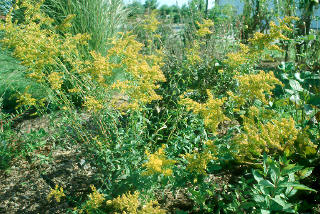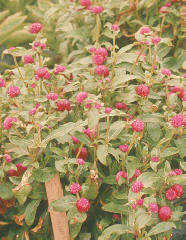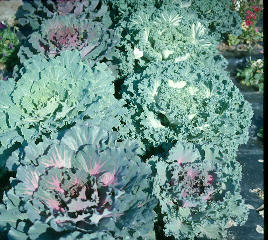Suggested plants for butterfly gardens
Butterfly bush (Buddleia davidii)
Dill (Anethum graveolens)
Goldenrod (Solidago)
Globe Amaranth (Gomphrena globosa)
Joe-pye weed (Eupatorium purpureum)
New England aster (Aster novae-angliae, Aster novi-belgii)
Ornamental Cabbage, (Brassica oleracea)
Parsley (Petroselinum crispum)
Back to Butterfly Gardening home page
 Butterfly bush (Buddleia davidii) family: Loganiaceae
Butterfly bush (Buddleia davidii) family: Loganiaceae
perennial, purple, lavender, white or pink blossoms, tiny flowers borne on spikes 6 to 12 inches long, deciduous shrubby plant, bloom period summer to fall, height 6-8 feet
propagation by seed and transplants can be purchased, plants can also be started from cuttings
culture, needs full sun and rich, well drained soil, flowers are produced on new wood so prune in spring before new growth starts
notable cultivars: Black Knight - dark violet to dark purple flowers, 6 to 8 inch flower spikes
 Dill (Anethum graveolens) family: Umbelliferae
Dill (Anethum graveolens) family: Umbelliferae
annual with a single upright stem, feather-like leaves are grey-green with a strong parsley-caraway smell, yellow flowers form in umbrella-like clusters and bloom in summer
propagate by seed, will self seed
culture, sow dill seeds in the spring or fall, prefers a sunny location with well-drained soil
notible cultivars: 'Bouquet’ and ‘Dukat’ – cultivars especially selected for their large yield of leaves
 Goldenrod (Solidago) family: Asteraceae
Goldenrod (Solidago) family: Asteraceae
perennial, bright golden yellow blossoms, leaves are slightly hairy, bloom period late summer, height 2 1/2 to 5 feet
spread 1 to 2 feet, native to Kentucky
propagation seeds can be purchased
culture, requires full sun and well-drained soil, divide plants in the spring every 3 or 4 years
notable cultivars: Golden Wings, Fireworks
 Globe Amaranth (Gomphrena globosa) family: Amaranthaceae
Globe Amaranth (Gomphrena globosa) family: Amaranthaceae
annual, small, round, clover-like 1 to 1 1/2 inch blooms, flowers may be purple, rose, lavender or white, bloom period summer (another source: midspring to early fall), height 9 inches to 2 feet, spread 6 to 8 inches
propagation by seed
culture, sow seeds indoors for early planting or outdoors after the soil warms, prefers hot summers
 Joe-pye weed (Eupatorium purpureum) family: Asteraceae
Joe-pye weed (Eupatorium purpureum) family: Asteraceae
perennial, pink-purple flowers, tiny 1/3 inch flowers formed in dense heads at the end of stems, bushy plant, native to Kentukcy, leaves with smooth margins in pairs or whorls, bloom period late summer from July to September, height 2 to 7 feet
propagation by seed
culture, full sun to partial shade
 New England aster (Aster novae-angliae or A. novi-belgii) family: Asteraceae
New England aster (Aster novae-angliae or A. novi-belgii) family: Asteraceae
perennial, soft pink, white, rose, red, blue, purple, violet blossoms, ray flowers around yellow center, flower heads 1 to 2 inches wide, flowers on hairy, sticky stems, lance-shaped leaves, bloom period late summer (another source: July to October), height 2 to 2 1/2 feet
propagation by seed
culture, grow in full sun in well-drained soil, pinch growing tips to induce branching, divide in the early spring
notable cultivars: Alma Potschke - flowers look like daisies, bright cerise with yellow center
 Ornamental Cabbage, (Brassica oleracea) family: Brassicaceae
Ornamental Cabbage, (Brassica oleracea) family: Brassicaceae
annual or tender biennial, smooth-leaved, center leaves of head may be pink, white, or red, blooms the second year, but flowers are of no value, height 10 inches
propagation by seed, start indoors for transplants or sow seed directly outdoors
culture, needs full sun
 Parsley (Petroselinum crispum) family: Umbelliferae
Parsley (Petroselinum crispum) family: Umbelliferae
hardy biennial, flowers only during the second growing season, usually grown as an annual since the foliage generally becomes more bitter during the second growing season, seeds produced during the second growing season will germinate and produce a new crop of foliage, forms a dense mound of foliage 6-12 inches tall and 12-15 inches wide
culture, grows best in moist, well drained soil in full sun, but it will tolerate some partial shade
notable cultivars: var. nepolitanum (Broad-leaf Italian Parsley), var. tuberosum (Turnip-rooted Parsley) forms a long edible root

